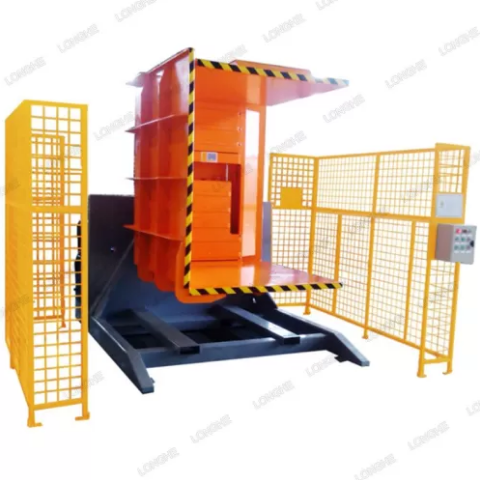Pallet Inverter Buyer's Guide
Pallet inverters are valuable machines in material handling and warehousing, designed to efficiently rotate pallet loads for various purposes. Whether you need to change damaged pallets, transfer goods, or access product layers, pallet inverters can save time and reduce manual labor. In this comprehensive buyer's guide, we will walk you through the important factors to consider when purchasing a pallet inverter.
1. Determine Your Application Needs
The first step in selecting a pallet inverter is to define your application requirements. Consider the following questions:
- Load Weight and Size: What are the maximum load weight and dimensions you need to handle? Ensure the pallet inverter you choose can accommodate your specific load parameters.
- Pallet Types: Do you work with standard wooden pallets, plastic pallets, or other specialty pallets? Ensure the inverter is compatible with the types of pallets you use.
- Rotation Angle: How much rotation is required for your application? Some inverters can tilt loads 180 degrees, while others can provide partial rotations, so determine your needs accordingly.
- Throughput: What is your required throughput rate? Some pallet inverters are designed for high-speed operations, while others are more suitable for low to medium throughput.
- Automation Level: Do you need a fully automated system, or is a manual or semi-automatic pallet inverter sufficient for your needs?
2. Safety Considerations
Safety is paramount when working with heavy loads and machinery. Ensure the pallet inverter you choose adheres to safety standards and has features to protect both operators and products. Look for the following safety features:
- Safety Fencing: Some pallet inverters come equipped with safety fencing or guarding to prevent operators from coming into contact with moving parts.
- Emergency Stop: An emergency stop button should be easily accessible, allowing operators to halt the machine in case of an emergency or malfunction.
- Load Retention: Ensure the inverter has mechanisms to secure the load during rotation, preventing accidents like load spillage.
- Locking Systems: Pallet inverters often have locking mechanisms to secure the load in an inverted position.
3. Power Source
Pallet inverters are available in various power configurations, including electric, hydraulic, and pneumatic options. Consider the power source that aligns with your facility and operations:
- Electric: Electric pallet inverters are reliable and offer precise control. They are suitable for operations with access to a consistent power source.
- Hydraulic: Hydraulic pallet inverters provide strong lifting capabilities and are ideal for heavy loads. They are often used in facilities with existing hydraulic systems.
- Pneumatic: Pneumatic pallet inverters use air pressure to operate. They are a good choice for facilities where electricity and hydraulics are limited or impractical.
4. Automation Level
The level of automation required for your operation depends on your throughput and labor resources:
- Manual: Manual pallet inverters are operated by employees, typically using hand cranks or controls. They are suitable for low to medium throughput operations.
- Semi-Automatic: Semi-automatic pallet inverters can automate certain functions but still require manual labor for loading and unloading.
- Fully Automatic: Fully automatic pallet inverters are equipped with automated loading and unloading systems, offering high-speed and continuous operation.
5. Installation and Space
Consider the space available in your facility and the installation requirements for the pallet inverter:
- Footprint: Ensure you have enough space for the pallet inverter and consider the layout to optimize workflow and access.
- Installation: Some pallet inverters require professional installation, while others can be easily set up by in-house personnel. Ensure you have the necessary infrastructure for installation.
6. Maintenance and Serviceability
Regular maintenance is essential to keep your pallet inverter operating efficiently. Consider the ease of maintenance and the availability of spare parts and service support:
- Service Network: Choose a manufacturer or supplier with a reputable service network and readily available spare parts.
- Maintenance Requirements: Understand the maintenance requirements, including lubrication, inspection, and potential downtime.
7. Budget and ROI
Determine your budget constraints and assess the return on investment (ROI) for the pallet inverter. Consider factors such as labor savings, increased efficiency, and potential product damage reduction when evaluating the long-term ROI.
8. Supplier Reputation and Support
Research and choose a reputable supplier with a history of delivering reliable pallet inverters. Read customer reviews, request references, and inquire about after-sales support and warranties.
9. Customization Options
Discuss customization options with your supplier if your application requires special features or modifications to the standard pallet inverter.
10. Environmental Considerations
Lastly, consider the environmental impact of your pallet inverter. Look for energy-efficient models and inquire about eco-friendly options if sustainability is a concern for your organization.
By thoroughly evaluating these factors and understanding your application requirements, you can make an informed decision when purchasing a pallet inverter. This will help ensure that your material handling operations run efficiently, safely, and in line with your business objectives.


